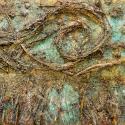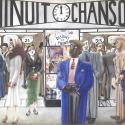How writers change their tune. When Robert Capa died in Vietnam in 1954, having trodden on a landmine, Ernest Hemingway was chief among those paying tribute. “It is bad luck for everybody that the percentages caught up with him,” he wrote. “It is especially bad for Capa. He was so much alive that it is a hard long day to think of him as dead.” Spool back, however, to Omaha Beach, 69 years ago to the month, when they came under enemy fire. Hemingway sought cover in a ditch and later accused Capa of putting him in danger so that he might “take the first picture of the famous writer’s dead body”.
It’s not quite right to say that Capa’s reputation rests on D-Day. After all, only 11 of the 106 frames he shot - the so-called Magnificent Eleven - survived a catastrophe in the London dark room where the rolls of film he sent back from the front were processed. It was from these splashy, blurred images, banged off in the surf as the bullets flew, that Spielberg really knew what invading Normandy in 1944 actually looked like. Prints of these unhappy few images are on show at a small gallery off Baker Street in London to which, if you can, you are urged to go. No need to shell out up to £6,000 for the privilege of owning one (prices varying according to rarity). Also on show are Capa’s images from the Spanish Civil War and others from the century’s upheavals. Like all the best pictures, they are worth a thousand words each.
 Capa was not really Capa. As explained in a magazine profile by John Hersey on display here, Hungarian-born Endre Friedmann and his girlfriend Gerda Taro jointly created the persona of an American photographer – his surname came from the Hungarian for “shark”. Taro, depicted here crouching behind a soldier on the front in Spain, was his distributor and contact with the outside world. She was no bad photographer herself, taking a heroic image of Capa in Segovia in 1937. His appearance exactly tallies with Hersey’s description: “short, swarthy and carrying itself as if braced for something, with spaniel eyes, a carefully cynical upper lip, and good luck in the whole face.” (Pictured above, Robert Capa's Camera, © Julia Bostock)
Capa was not really Capa. As explained in a magazine profile by John Hersey on display here, Hungarian-born Endre Friedmann and his girlfriend Gerda Taro jointly created the persona of an American photographer – his surname came from the Hungarian for “shark”. Taro, depicted here crouching behind a soldier on the front in Spain, was his distributor and contact with the outside world. She was no bad photographer herself, taking a heroic image of Capa in Segovia in 1937. His appearance exactly tallies with Hersey’s description: “short, swarthy and carrying itself as if braced for something, with spaniel eyes, a carefully cynical upper lip, and good luck in the whole face.” (Pictured above, Robert Capa's Camera, © Julia Bostock)
Capa’s photographs aren’t all of Sturm und Drang and combat. His first published image was of Trotsky haranguing from a Copenhagen podium. Capa’s reportorial eye had a feel for motion – Trotsky’s clawed hands seem to wave kinetically in front of you. Later in Spain you can all but see dispossessed refugees trudging disconsolately across his framed field of vision (oddly, always left to right). And Capa’s are intensely loud pictures too: rifles go off as Republication women volunteers do firing practice, or bereaved Neapolitan mothers clamour in the streets, bombs detonate, planes roar invisibly overhead, crowds huzzah in liberated Paris.
 Amid all this he was capable of composing pictures of extraordinary stillness – of tiredness, sleep and, in one image in Berlin, death. (Pictured left, Little girl resting during the evacuation of the city, Barcelona, 1939 © Robert Capa/Magnum Photos). And in this relentless chronicle of disruption and dolour, there is redemption too in Italian children crowding around a GI or two young Republican volunteers sitting in the Barcelona sun, their teeth glistening as they laugh and talk perhaps of love – the rifle standing to attention in the young man’s hand hints as much (see gallery below).
Amid all this he was capable of composing pictures of extraordinary stillness – of tiredness, sleep and, in one image in Berlin, death. (Pictured left, Little girl resting during the evacuation of the city, Barcelona, 1939 © Robert Capa/Magnum Photos). And in this relentless chronicle of disruption and dolour, there is redemption too in Italian children crowding around a GI or two young Republican volunteers sitting in the Barcelona sun, their teeth glistening as they laugh and talk perhaps of love – the rifle standing to attention in the young man’s hand hints as much (see gallery below).
Mystery surrounds the celebrated image which established Capa’s international reputation. Loyalist Militiaman at the Moment of Death, Cerro Muriano, September 5, 1936, also known as The Falling Soldier, possibly didn’t record an actual death and, according to a Japanese documentary broadcast earlier this year, is almost certainly the work of Taro. Capa would remain notably reticent about it, and as she was killed in a collision with a tank in Spain in 1937, she took the secret to the grave.
If indeed it was staged, it belongs in a not entirely dishonourable tradition of wartime propaganda briefly illustrated in this same exhibition. There are 11 images by Soviet war photographer Dimitri Baltermans, dating from the German invasion of 1941 through to the conquest of Berlin, when Baltermans and Capa would have been pounding the same streets. His photoshopped incitements to heroism have all the hallmarks of socialist realist sentimentality, but others feel more like dramatic reports from the front in the journalistic 19th-century tradition of Vereshchagin. Compare and contrast.
- Death in the Making: Photographs of War by Robert Capa at the Atlas Gallery until 6 July
Click on the images to enlarge





![SEX MONEY RACE RELIGION [2016] by Gilbert and George. Installation shot of Gilbert & George 21ST CENTURY PICTURES Hayward Gallery](/sites/default/files/styles/thumbnail_125_x_125_/public/mastimages/Gilbert%20%26%20George_%2021ST%20CENTURY%20PICTURES.%20SEX%20MONEY%20RACE%20RELIGION%20%5B2016%5D.%20Photo_%20Mark%20Blower.%20Courtesy%20of%20the%20Gilbert%20%26%20George%20and%20the%20Hayward%20Gallery._0.jpg?itok=3oW-Y84i)









Add comment